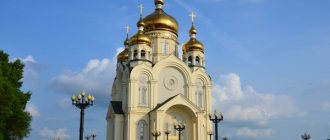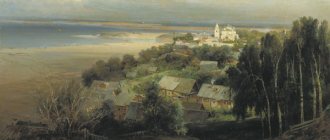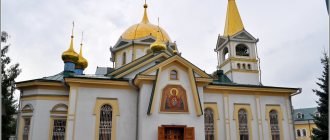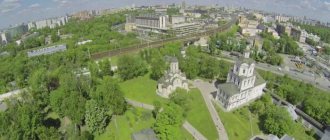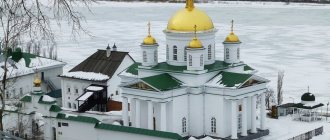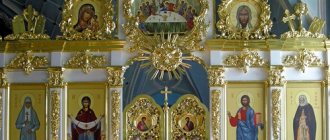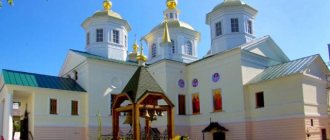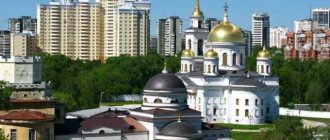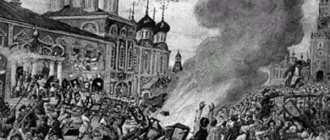| Nizhny Novgorod Alexander Nevsky Cathedral. Photo ok. beginning XXI century |
Nizhny Novgorod Cathedral in the name of the Blessed Grand Duke Alexander Nevsky of
the Nizhny Novgorod diocese
- Thrones: blgv. led book Alexander Nevsky (chief); St. Macarius of Zheltovodsky (altar); St. Nicholas of Myra (side chapel); equal to Mary Magdalene (altar)
- Address: Russia, 603086, Nizhny Novgorod, Kanavinsky district, st. Strelka, 3a
- Tel. (rector), 277-99-80 (security)
- Official site:
- Directions: to the “Strelka” stop
- On the map: Yandex.Map, Google map
The cathedral stands on the traditional site of the fair, on the strelitsa - the confluence of the Oka and Volga. Visible both from the upland and trans-river parts of the city, and from the fairway of the Volga and Oka rivers.
Construction
In 1817, the Makaryevskaya Fair, famous throughout Russia, was transferred from under the walls of the Makaryevsky Zheltovodsky Monastery to Nizhny Novgorod. On the territory of the fair, the Spassky Cathedral was built according to the design of Auguste Montferrand, but one temple was not enough and a decision was made to build another church for the fair.
In 1856, the merchants petitioned the Bishop of Nizhny Novgorod for the construction of a new cathedral. Nizhny Novgorod Bishop Anthony (Pavlinsky), in turn, turned to Governor Alexander Nikolaevich Muravyov, who gave the matter the proper course in 1858. Initially, they intended to dedicate the temple to St. Nicholas, but on August 24 of that year the emperor, his wife and daughter visited Nizhny Novgorod, which changed the course of events. In memory of the visit, the merchants decided to build a temple with thrones in the name of the heavenly patrons of royal persons: the blessed Prince Alexander Nevsky as the patron of Alexander II and Grand Duke Alexander Alexandrovich; Equal to the Apostles Mary Magdalene as the patroness of Empress Maria Alexandrovna and Grand Duchess Maria Alexandrovna; St. Nicholas of Myra as the patron saint of Grand Duke Nikolai Alexandrovich of blessed memory.
Fundraising for construction has begun. By 1862, the collected amount of 60 thousand rubles made it possible to begin to implement the plans. Provincial architect Robert Yakovlevich Kilevein drew up a construction plan. The basis of the project was the drawing of the St. Petersburg Annunciation Church of the Life Guards Cavalry Regiment according to the plan of K. A. Ton. The first stone was laid by Grand Duke Vladimir Alexandrovich, who arrived in Nizhny Novgorod on July 15, 1868. The construction was led by architects R. Ya. Kilevein and Lev Vladimirovich Dal. Over the next two years, the walls of the temple were erected and the ceiling was made. Finishing work continued until the end of construction. In addition to the icons painted by the Moscow icon painter F. A. Sokolov, icons of Macarius of Zheltovodsk, the Savior Not Made by Hands and others were brought to the temple from the Makaryevsky Monastery liquidated after the fire. The iconostasis of the temple reached 23 meters in height.
| Nizhny Novgorod Alexander Nevsky Cathedral. Photo by Andrey Karelin. |
In 1880, the temple was transferred to the Nizhny Novgorod diocese and received a staff: a priest, a deacon, and a psalm-reader.
The consecration of the main altar followed on July 20, 1881. The temple did not have a permanent parish: it was composed of merchants who came to the fair. Therefore, the main room functioned only during the fair, and was not heated in winter. In the western vestibule there was a winter heated church of Macarius of Zheltovodsk and Unzhensky. The temple was a meeting place for honored guests of the city - the august family, Orthodox hierarchs. In August 1896, Metropolitan Michael of Serbia visited the cathedral.
Devastation
According to the authorities, in 1929 the influx of parishioners into the temple - local housewives and the "unorganized" population - "caused inconvenience." Therefore, at the end of the year, the valuables were confiscated, and in the winter of 1930, by decision of the leadership of the Volga Flotilla, the iconostases and all the wooden decorations of the cathedral were used for firewood to heat local houses. The parishioners managed to save only a few icons, including the revered icon of the Mother of God and the Life-Giving Cross. The project for the reconstruction of the former fairgrounds, developed in the late 20s, included the demolition of the cathedral and the erection in its place of a lighthouse with a monument to Lenin. In fact, the project ended only with the dismantling of the tents. Subsequently, the cathedral building was used for warehouses and partly for housing. Numerous buildings that disfigured the temple housed utility rooms.
During the Great Patriotic War, an anti-aircraft battery stood on the central drum of the cathedral, protecting the Nizhny Novgorod sky from enemy raids. In the 1940s, a fire occurred in the temple building, destroying the interior of the cathedral and the paintings on the ceiling and walls. After this, the remains of the interior plaster were completely knocked off.
Recovery
In 1983, restoration began according to the design of architects O. E. Sundieva and I. S. Agafonova. Work to restore the tents proceeded slowly.
In July 1991, on the days of the transfer of the relics of St. Seraphim of Sarov, the temple was visited by Patriarch of Moscow and All Rus' Alexy II. In September of the same year, restoration work began in the cathedral and in the surrounding area, which continued until the 2010s. The temple was rededicated in 1992. Soon an efficient heating system was installed in the temple, and a new iconostasis design was developed. The full consecration took place in 1999. Meanwhile, the temple returned to the jurisdiction of the Church and was designated the cathedral of the Nizhny Novgorod diocese. Patriarch Alexy II visited the cathedral again in November 2005, when Russia celebrated National Unity Day for the first time; Patriarch Kirill - September 12, 2009 and November 4, 2011. At the beginning of the 21st century, educational activities were launched at the cathedral - there was a Sunday school, catechist courses, a library of Orthodox literature, and an icon-painting workshop.
How to get there by public transport
The temple, located in the historical part of the city, can be easily reached by any type of public transport, and then walk a short distance towards the visible cathedral.
| Kind of transport | No. of routes | Stop name |
| Bus | 3, 19, 26, 41, 43, 52, 61, 90 | "Strelka" on Sovetskaya Street |
| Minibus taxi | 18, 50, 70, 87, 91, 92, a-71, t-37, t-40, t-41, t-42, t-45, t-47, t-57, t-90 | "Arrow" |
| Metro | Blue line of the underground metro line | Strelka station |
You can take a taxi, which can easily take you directly to the cathedral square or anywhere in the city.
How to get there
The temple stands in the Kanavinsky district of the city, not far from the river port, on the street. Strelka, 3A. To get to it, you need to take buses or minibuses to the “Strelka” or “Castorama shopping center” stop, and then walk about 0.7 km to the temple. The cathedral is 2.3 km away from the Moscow railway station. This distance can be walked or taken by taxi.
Attraction rating:
Rating 4.13 [8 vote(s)]
| ← N.NOVGOROD | NIZHNY NOVGOROD REGION Cathedrals of Nizhny Novgorod | RUSSIA → |
History of the temple
Alexander Nevsky New Fair Cathedral was erected at the request of the Nizhny Novgorod merchants in the middle of the 19th century, when the summer fair, famous throughout the country, reached unprecedented proportions, attracting up to 200 thousand visitors, which led to the impossibility of accommodating all the willing parishioners in the existing temple.
The original idea of building a 1-altar church was changed after the visit of the Nizhny Novgorod fair by the current Emperor Alexander II with the royal family in 1858. The merchants decided to perpetuate this event by erecting a majestic temple with 3 thrones in honor of the Holy members of the royal family, and this plan received the approval of the king.
The emperor himself indicated the place for the construction of the temple on the arrow. And although the initial amount of donations was collected very quickly, the start of construction was delayed until September 1867, when, in the presence of Grand Duke Vladimir Alexandrovich, the first stone was symbolically laid in the foundation of the future cathedral.
The construction of the church took place under the technical supervision and guidance of the main member of the established committee for the construction, J. Kileveyn, with the participation of Lev Dahl, who served as his chief assistant.
Two years later, in July, the then future Emperor Alexander III and his wife visited the construction of the cathedral, and 14 years later, he, along with the Grand Dukes George and Alexei, as well as Tsarevich Nicholas, took part in the celebrations of the consecration of the temple.
For a long time, the cathedral became the main place for ceremonial receptions of honorary Orthodox guests of the city.
During the years of revolutionary hard times the temple was closed. They planned to demolish it and transform the entire fairground with a giant lighthouse and a monument to Lenin. But the project did not come to fruition; everything was limited only to the dismantling of the domes on the cathedral building, converted into warehouses, office and residential premises.
All the interior decoration and church utensils were looted and partially destroyed; the unique wooden iconostasis was used to heat the living rooms. Some valuables and shrines were saved, including an ancient icon of the Mother of God and the Life-Giving Cross.
A fire in the middle of the last century completely destroyed the interior and the remains of the temple painting. During the war years, an anti-aircraft battery was placed on the roof of the cathedral. Renovation of the cathedral began in 1983, mostly by volunteers from local residents under the leadership of a team of professional restorers and architects.
Alexander Nevsky New Fair Cathedral. Photos from the early 20th century
In 1992, the building was officially transferred to the ownership of the Orthodox Church, and regular services began here, but at first exclusively in the Makaryevsky limit.
And only 6 years later the central temple throne was re-consecrated in honor of Alexander Nevsky, in April of the following year - the throne of Mary Magdalene, and already in May - the throne of the saint of God Nicholas. The completion of the repair and restoration work of the temple building stretched until the end of the last century.
By 2006, the restoration of the building was completed, work began on interior decoration, decoration and church painting, and 3 years later the metropolitan see was moved here.
Particularly difficult was the reconstruction of the 23-meter iconostasis, which historically could not be recreated; it was manufactured and installed according to a newly developed engineering design.
Don't miss the most popular article in the section: Metro Nizhny Novgorod. Diagram, map, description.
"Cathedral" bell
On the approach to the Alexander Nevsky Church from the south, tourists see a huge four-meter bronze bell
, which is called “Cathedral”.
This giant 60-ton
bell was made for the
400th
anniversary of the creation of the People's Militia under the leadership of K. Minin and D. Pozharsky. In terms of its dimensions, the Cathedral takes an honorable third place after the bell of the Trinity-Sergius Lavra and the Moscow one.
"Cathedral" bell
iconography is very beautiful and unusual.
with images of such saints as S. Sarovsky, A. Nevsky and Macarius of Zheltovodsk. On the bell there is an image of Prince Georgy Vsevolodovich, the founder of Nizhny Novgorod and other images.
The image of Patriarch Kirill on the “Cathedral” bell
The inscription running along the bottom of the bell
perpetuates all those who contributed to its creation.
The design part of the work on the production of this unique giant was carried out by Moscow specialists from the Society of Old Russian Musical Culture. The bell was cast at the Baltic St. Petersburg plant. Work on the production of bas-relief, ornaments and inscriptions was carried out by sculptor A. Zabaluev
. The belfry for the bell is completed.
Today, not far from the Alexander Nevsky Church, another original Nizhny Novgorod object appeared - the Nizhny Novgorod Stadium.
.
This sports facility, as a tribute to modernity, was built on Strelka for the 2108 FIFA World Cup
. It hosted football teams and city guests for six matches, and its appearance harmoniously fit into the architectural composition of Strelka.
Author of the article: Kasatkina Tatyana
Architect and exterior decoration of the cathedral
It is difficult to unambiguously determine the style of this huge, but very harmonious structure with powerful 8-sided tents, reminiscent of the towers of the Middle Ages. Experts attribute the majestic and original brick cathedral to eclecticism, focused on the project of Ton and the Annunciation Church of St. Petersburg, but redesigned by ordinary employees of the capital department.
The architect of the final project was a talented architect, the son of the famous linguist and compiler of an explanatory dictionary, Lev Vladimirovich Dal.
The temple was built unconventionally, without a pile foundation, but in the form of a centric monumental structure of a solid slab, laid with stone masonry on a wooden raft base. The design is unique, developed by R.Ya. Kilewein based on the results of a thorough geological study of the soil, which provided for the possibility of uniform shrinkage and greater durability of the foundation.
The main large tent of the temple was erected using load-bearing metal structures made by Arzamas craftsmen according to special calculations by P.I. Tsybysheva. Small church domes were also built using metal frames.
The original appearance of the building consisted of unplastered red brick facades with white rustications and checkered-painted tents.
The following typical elements can be distinguished from the main architectural decorations of the temple:
- tents;
- bulbous heads;
- 8-sided drums;
- Byzantine windows;
- kokoshniks;
- complex profiles of cornices.
The cathedral is a typical example of architecture of the mid-19th century, and the well-chosen scale and silhouette of the building put it among the outstanding buildings of Nizhny Novgorod urban architecture.
Today the walls of the temple are plastered and painted with ocher, which gives a more solid and austere appearance to the structure.
Architectural ensemble of the cathedral
The brick building of the temple, square in plan, is represented by a 5-tent centric composition with a vestibule protruding in the west, on the 2nd floor of which there was a permanent heated church dedicated to the holy Venerable Macarius of Zheltovodsk and the Wonderworker of Unzhensk.
The huge square temple room with a side length of 33.5 m was accessible to parishioners only during the summer period of the fair.
The main 8-sided drum with a brick dome and 14-meter span was supported by girder arches, creating sail vaults mounted on 4 monumental internal support structures of complex configuration. The height from the internal floor mark to the central domed vault is 44.5 m.
The ceilings in the small drums on the western side formed the structure used for the belfry. The southern vestibule of the temple is symmetrical to the northern one, and together with the altar protruding part, they are made in the form of 5-sided structures, installed on rectangular bases with semi-domed vault ceilings.
On the territory of the temple there is a church shop, a spiritual and educational center, a restoration workshop, and a cathedral refectory where anyone can drink tea with local pies.
Address: N. Novgorod, st. Strelka, 3a.
Tel/fax – office.
Website: https://nevskiy-nne.ru/
Directions to the Strelka stop
Buses No. 3,4,19, 26, 38,41, 43, 52, 61, 90
Route taxis: 2, 3a, 5, 6, 7, 18, 19, 33, 34, 37, 40, 41, 42, 44, 45, 47, 57, 71, 72, 90, 117.
“Orthodox parish of the cathedral in the name of the holy noble prince Alexander Nevsky in Nizhny Novgorod.”
SCHEDULE OF SERVICES:
Daily
Mon-Sat: 09.00 – Confession, hours. Divine Liturgy. 17.00 – Vespers, Matins.
Sun: 06.00 – Early Liturgy. 08.00 – Paraklis of the Mother of God. 09.00–Late liturgy, prayer service. 17.00–Vespers, Matins
Prayers after the liturgy:
Tue. - prayer service to St. blgv. book Peter and Prince Fevronia Muromsky
Wed – prayer service with akathist to the martyr. Cyprian and MCC. Justinia
Thurs. – prayer service with akathist to St. blgv. book Alexander Nevsky
Fri. – prayer service with akathist to St. Luka Krymsky
Sat. – 16.00 – prayer service with akathist to St. bliss Matrona of Moscow
Days and times of baptism (adults, children): Sat. – 12.00
Mandatory catechetical conversations, conversations before the wedding: daily Mon.–Sat. – 11.00–17.00, Sun. – 12.00–16.00
STORY:
Throne
The main chapel was consecrated in honor of the holy noble prince Alexander Nevsky (06.12/12.09)
Right - in honor of the Myrrh-Bearing Equal-to-the-Apostles Mary Magdalene (04.08)
Left - in honor of the saint and wonderworker Nicholas of Myra (12/19/22/05)
Upper - in honor of St. Macarius of Zheltovodsk (07.08)
Shrines
Icon of the All-Merciful Savior The icon of the Savior was painted in 2008 by cathedral icon painters and is an exact copy of the 14th century icon, which is located in the Church of the Resurrection of Christ in the city of Tutaev, Yaroslavl region.
Belt of the Blessed Virgin Mary The cathedral contains an embroidered belt that was attached to the honorable Belt of the Blessed Virgin Mary, which was in the cathedral from November 4 to 6, 2011. Over the course of three days, more than 250 thousand people venerated the great shrine of the Christian world.
Icon of the Holy Blessed Prince Alexander Nevsky The icon of the cathedral's patron was presented as a gift by His Holiness Patriarch Alexy II of blessed memory on November 3, 2005 after the all-night vigil. In 2008, during the visit of Archbishop George of Nizhny Novgorod and Arzamas to St. Petersburg, with the blessing of Metropolitan Vladimir of St. Petersburg and Ladoga, a particle of the relics of the holy prince was donated to the cathedral.
SVMC icon. Cyprian and martyr. Justinia The icon with particles of the holy relics of the Hieromartyr Cyprian and the Martyr Justinia was brought in April 2005 by the hierarch of the Cypriot Orthodox Church, Metropolitan Neophytos of Morphia and donated to the Nizhny Novgorod diocese.
Icon of the Holy Blessed Matrona of Moscow The icon with a particle of the relics of the blessed Matrona was painted in the icon-painting workshop at the cathedral in 2010. In 2012, holy relics were placed in the icon. Next to the icon there is a chest into which believers drop notes with requests to Mother Matrona.
Icon of the Holy Blessed Princes Peter and Fevronia The icon of the Holy Blessed Princes Peter and Fevronia, the Murom miracle workers, was painted and consecrated in 2009, at the same time the honest relics of the saints of God were put into the icon.
Icon of the Saints of the Nizhny Novgorod Land The icon of the Council of Saints of the Nizhny Novgorod Land was painted in 2008 for the first celebration of the Council of Nizhny Novgorod Saints, which took place on September 14, 2008 in the Alexander Nevsky Cathedral. On the same day, the ruling bishop performed the rite of consecration of the icon. Subsequently, particles of the relics of those Nizhny Novgorod saints who remain as honest relics on Nizhny Novgorod land were put into it.
Icon of the Solovetsky Saints The icon of the Venerables Zosima, Savvaty and Herman, Solovetsky wonderworkers, was painted in 2012 for the offering of shrines to the Solovetsky Monastery from January 27 to February 10, 2013. These days, in the basement of the cathedral, the exhibition “Solovki. Golgotha and Resurrection." Before the opening of the exhibition, the abbot of the monastery, Archimandrite Porfiry, donated the holy relics of the Solovetsky wonderworkers to the cathedral in honor of the holy noble prince Alexander Nevsky, after which they were placed in the icon.
Icon of St. Herman of Alaska The icon of St. Herman of Alaska was painted in 2011. In the same year, Metropolitan Jonah of All America and Canada donated a particle of the saint’s relics to the Nizhny Novgorod diocese.
Icon of the Holy Blessed Grand Duke George Vsevolodovich The icon of the founder of Nizhny Novgorod, Holy Blessed Grand Duke George Vsevolodovich, was painted in the icon-painting workshop at the Alexander Nevsky Cathedral in December 2009. In the same year, on December 16, a particle of the holy relics of the blessed prince was brought from the Vladimir diocese and placed in the icon.
Icon of Saint and Wonderworker Nicholas with a particle of the relics Icon with a particle of the relics of St. Sergius, Abbot of Radonezh, wonderworker History
Architects: Lev Vladimirovich Dal and Robert Yakovlevich Kilevein. Consecrated in 1881, again in 1992, and in full rites in 1999.
The Cathedral in the name of the Holy Blessed Prince Alexander Nevsky rises on Strelka - the traditional venue for the Nizhny Novgorod fair. It is visible both from the upland and trans-river parts of the city, and from the fairway of the Volga and Oka rivers. The grandiose height of the cathedral (87 m) still provides it with third place among Russian churches after the Cathedral of Christ the Savior in Moscow and St. Isaac's Cathedral in St. Petersburg.
Its history began in the mid-50s of the 19th century, when the central Spassky Cathedral in the fair trade complex of Kunavinskaya Sloboda could no longer accommodate all the believers, and the merchants turned to Bishop Anthony with a petition to build a new cathedral, who in turn sent a petition to Governor A .N. Muravyov.
In 1858, on the Kunavinskaya Sloboda in the Nizhny Novgorod Fair shopping complex, it was decided to build a temple in the name of the savior and wonderworker Nicholas of Myra, but this proposal was destined to change in the same year. As eyewitnesses recalled, “On August 24, the fair had the good fortune to see Emperor Alexander Nikolaevich, of blessed memory, and Empress Maria Alexandrovna. The merchants were happy with the visit of Their Majesties to the fair. In memory of their devotion to Orthodoxy and the Throne, they decided to build not only a temple that would satisfy the religious needs of traders, but a majestic temple, perpetuating the patriotism of their loyal subjects to their sovereign and their august family. Why, at the meeting on August 24, 1858, the merchants, through their most important representatives, expressed a desire to build three thrones in the proposed temple: the first - in the name of the holy noble prince Alexander Nevsky - the namesake of His Imperial Majesty, the most pious sovereign Emperor Alexander II and His Imperial Highness, the Grand Duke Alexander Alexandrovich; the second - in the name of the holy Equal-to-the-Apostles Myrrh-Bearer Mary Magdalene - the namesake of the Empress Maria Alexandrovna, and the third - in the name of the saint and wonderworker Nicholas of Myra - the namesake of the Tsarevich and Grand Duke Nicholas Alexandrovich of blessed memory."
At the same meeting, a beginning was made for the implementation of a good deed: a voluntary collection of donations was opened for the construction of the temple. Donations for the first time turned out to be up to 2,000 rubles. Only by 1862 the collected amount of 60 thousand rubles made it possible to begin to implement the plans.
Of all the proposed projects, the construction commission settled on the project of the provincial architect R.Ya. Kileveyna. Archival research has established that the design was based on a drawing of the Annunciation Church of the Life Guards Cavalry Regiment in St. Petersburg, built according to the design of K.A. Tones. The main idea of the project was to connect five tents in one building. However, the estimate, as it turned out, was at least twice the amount planned by the merchants of 100 thousand rubles.
On November 18, 1865, the Sovereign Emperor approved the project, but the construction of the temple began only in September 1867, after the election of a new construction committee, which included people who could provide real help.
The first stone for the foundation of the temple was laid by Grand Duke Vladimir Alexandrovich, who arrived in Nizhny Novgorod on July 15, 1868. In 1869–1870, the walls of the temple were erected and the ceiling was made. Design work continued until the end of construction. In addition to those painted by the Moscow icon painter F.A. Sokolov icons, icons from the Makaryevsky Monastery, liquidated after the fire, were brought to the temple - St. Macarius of Zheltovodsk, the Savior Not Made by Hands and others.
The construction work was supervised by architects R.Ya. Kilewein and L.V. Dahl, whose original project for the New Fair Cathedral remained unfulfilled.
Nizhny Novgorod merchants, the Remizov brothers, supplied lumber and metal products, Zarubin supplied stone. The largest quantities of bricks for the construction were provided by the merchant Dolgopolova, the merchant Rukavishnikov, and the owner of the brick factory, the peasant Petelkin.
In 1880, the construction of the temple was completed, it was transferred to the Nizhny Novgorod diocese and received a staff: priest, deacon, psalm-reader. The main altar of the temple - in the name of the holy noble prince Alexander Nevsky - was consecrated on July 20, 1881.
Since the temple did not have a permanent parish (it was made up of merchants coming to the fair), the main building functioned only during the fair, and was not heated in winter. The winter heated church of Macarius of Zheltovodsk and Unzhensky was located in the protruding western vestibule.
During the period of revolutionary upheavals, the temple experienced a series of persecutions and desecrations. By this time the Cathedral of St. blgv. Prince Alexander Nevsky became very popular not only among the merchants, but also among the common people. In the temple there was a miraculous icon of the Mother of God and the Life-giving Cross of the Lord, to which many suffering people resorted. According to the authorities, in 1929 the influx of such parishioners into the temple - local housewives and the unorganized population - “caused inconvenience.” Therefore, at the end of the year, the valuables were confiscated, and in the winter of 1930, by decision of the leadership of the Volga Flotilla, the iconostases and all the wooden decorations of the cathedral were used for firewood to heat local houses. The parishioners managed to save only a few icons, including the icon of the Mother of God and the Life-Giving Cross, which until recently were in the Vysokovskaya Church.
The project for the reconstruction of the former fairgrounds, developed in the late 20s, included the demolition of the Alexander Nevsky Cathedral and the erection in its place of a lighthouse with a monument to Lenin. But, fortunately, the project ended only with the dismantling of the tents. Subsequently, the cathedral building was used for warehouses and partly for housing. Numerous buildings that completely disfigured the temple housed utility rooms. In the early 1940s, a fire occurred in the cathedral building, destroying its interior and paintings on the ceiling and walls.
During the Great Patriotic War, an anti-aircraft battery stood on the central drum of the cathedral in the name of the Holy Blessed Prince Alexander Nevsky, protecting the Nizhny Novgorod sky from enemy raids.
A new era for the Alexander Nevsky Cathedral began in the 80s of the twentieth century, when, according to the design of architects O.E. Sundieva and I.S. Agafonova began restoration work to restore the torn down tents. The work proceeded slowly, since it was difficult to find the right metal for the manufacture of ceilings and other tent elements. It should be noted that the workers of the Kulebaki Metallurgical Plant took on the task of completing such a complex order. There were other difficulties at work.
But since 1992, in parallel with the restoration, services have been resumed in the cathedral. Soon an efficient heating system was installed in the temple, and a new iconostasis design was developed. New - because the secret of the old masters, who installed and secured the 23-meter (the size of an eight-story building) iconostasis in the last century, could not be discovered. Much had to be restored from photographs.
And again, before us is the former temple - centric, five-tented, the architectural masses from the porches and side tents grow upward, rushing towards a powerful central tent with a large gilded dome.
In plan, the cathedral has the shape of a “Greek cross”. The cross-domed structure of the temple and a number of details of the facades reflected the official understanding of Russian national religious architecture. This is the last building in the city, built on the basis of the “exemplary” designs of K.A. Tones. The general appearance of the cathedral, the successfully found dimensions and silhouette, the scale of the main proportions place it in one of the first places in importance in the river facade of Nizhny Novgorod.
Both before the revolution and after its second birth, the cathedral in honor of the holy noble prince Alexander Nevsky was a meeting place for honored guests - the august family, Orthodox hierarchs. The cathedral was visited twice by His Holiness Patriarch Alexy II of Moscow and All Rus' - in 1991 during the transfer of the relics of St. Seraphim of Sarov and in November 2005, when Russia first celebrated the national holiday National Unity Day.
Interior decoration
For the interior decoration, the cathedral received ancient icons from the burnt Makaryevsky Monastery. Many icons for the temple were painted by the talented Moscow painter Fyodor Sokolov.
Alexander Nevsky Cathedral in Nizhny Novgorod
The huge wooden iconostasis was 23 m high and separated the altar from the main room of the temple. Modern masters have not been able to completely recreate it. The new iconostasis was completely made according to a new engineering design.
The lost interior and frescoes were made during the period of restoration work in the temple by modern masters based on scanty information and surviving photographs.
Current state[edit]
In 1983, the restoration of the cathedral began, during which time volunteer restorers actively took part. In 1989, restoration of the torn-down temple tents began. In February 1991, the Brotherhood was created in the name of the Holy Blessed Grand Duke Alexander Nevsky, and in June 1992 the cathedral was returned to the Church. Since 1992, services began in the winter chapel of St. Macarius. On December 30, 1998, Metropolitan Nicholas of Nizhny Novgorod and Arzamas consecrated the central Alexander Nevsky throne of the temple. On April 24, 1999, the Mariinsky chapel was consecrated, and on May 18, the St. Nicholas chapel.
Divine services began to be held in the main building of the cathedral; but the restoration continues.
For the cathedral, it was necessary to develop a new iconostasis design, since the secret of the old masters, who installed and secured in the last century a 23-meter high one - the size of an eight-story building! — iconostasis, could not be opened.
They will try to restore the external decoration of the iconostasis using old surviving photographs.
On September 8, 2009, Archbishop Georgy celebrated the Divine Liturgy, and at its end he consecrated the new cathedral icon of the Image of the Savior Not Made by Hands - a copy of the miraculous image of the Tutaevsky Most Merciful Savior, painted in the icon-painting workshop "Tradition".
On September 12, 2009, the Cathedral in honor of the Holy Prince Alexander Nevsky in Nizhny Novgorod was given cathedral status.
In October 2009, the painting of the prayer room in the Avtozavodsky boarding school for children with developmental problems was completed. The boarding school has been supported by the parish of the cathedral since the late 1990s.
Work on the interior painting of the cathedral began in April 2010. In 2010, the painting of the altar was completed, and in the summer of 2011 they began painting the two supporting columns. The total area of paintings will be 11 thousand m². On July 1, 2010, Archbishop Georgy consecrated the Kazan image of the Mother of God - the first of 187 icons of the Mother of God planned for installation in the cathedral. During the consecration, the icon was installed in a large icon case near the left column. In August 2011, work was completed on the Don Icon of the Mother of God, a copy of an ancient example kept in the Tretyakov Gallery.
On November 4, 2011, the Belt of the Blessed Virgin Mary was delivered to the cathedral. The shrine was installed in the center of the cathedral and remained there until November 6. During this time, about 170 thousand people bowed to her, including Patriarch Kirill and Russian President Dmitry Medvedev.
It is planned to reconstruct the area around the cathedral in order to increase its transport accessibility.
The installation of a bell in honor of the 400th anniversary of the feat of the Nizhny Novgorod militia Kuzma Minin and Prince Dmitry Pozharsky is planned at the confluence of the Oka and Volga, 300 meters from the Alexander Nevsky Cathedral. Until this time, the bell was placed on a temporary belfry at the southern entrance to the cathedral.
The bell creation project is being implemented with the blessing of Patriarch of Moscow and All Rus' Alexy II.
This is the third largest bell in Russia (after the Tsar Bell in Moscow and the bell in the Trinity-Sergius Lavra).
Its height and diameter coincide and are equal to 4 meters. Weight 60 tons. Made from bell bronze (80% copper and 20% tin).
Along the lower belt of the bell there is an inscription perpetuating the names of all the trustees and benefactors who took part in its creation. The design and construction of the belfry is being carried out, the casting of the bell will be carried out at the Baltic Plant in St. Petersburg, the artistic design and sound are supervised by specialists from Moscow.
The casting of the bell took place at the Baltic Plant on October 5, 2011. The work was carried out for several hours. Three weeks were allotted for the bell to cool down.
Shrines and relics of the temple
Alexander Nevsky New Fair Cathedral is rich in various shrines and relics, attracting Orthodox believers and numerous pilgrims for worship:
- copy from the 14th century icon of the All-Merciful Savior;
- the image of the patron saint of the temple, Prince Alexander Nevsky, with a piece of relics;
- belt of the Most Pure Mother of God;
- reliquary and image of the blessed Matrona of Moscow;
- an icon of the grand ducal married couple Peter and Fevronia with pieces of the honest relics of the Murom wonderworkers;
- the first unique and only image in the country of the Holy Martyr Cyprian and the Martyr Justina with pieces of venerable relics brought as a gift to the cathedral from Cyprus;
- a cathedral image of all the saints in the land of Nizhny Novgorod who shone with numerous pieces of relics;
- icon of the Holy Solovetsky Wonderworkers with pieces of relics;
- a shrine from the island of Corfu - a shoe from St. Spyridon of Trimythous;
- relics of the Holy Warrior Theodore Ushakov.
Arks:
- with pieces and relics of Russian Saints and Reverend Elders of Optina;
- with a piece of the relics of the healer Great Martyr Panteleimon;
- with the relics of St. Seraphim of Sarov;
- from the Greek Orthodox Church with pieces of the relics of St. John of Damascus;
- with the relics of St. Macarius of Zheltovodsk;
Content
- 1 History of the cathedral 1.1 Project and fundraising
- 1.2 Construction
- 1.3 Spiritual nourishment
- 1.4 Confiscation of property, Soviet era
- 1.5 Revival of the temple
- 1.6 Painting
- 1.7 Worship of the belt of the Virgin Mary
- 1.8 Cathedral Bell
- 1.9 Own shrines and relics
- 2.1 Educational activities
- 4.1 Address
Service schedule, operating hours
The cathedral is active and is open to parishioners and tourists on weekdays from 8 a.m. to 7 p.m. Church services are held here every day. The Divine Liturgy begins daily at 9 o'clock. Before this, confession takes place. Half an hour before the start of the hour, prayers to the Saints are performed.
On Sundays and holidays, an additional early liturgy is held, which begins at 6 a.m. Evening services take place daily from 5 p.m.
The first Sunday school in the city for children and adults, catechetical courses, and a large Orthodox library have been operating at the church for many years. Not long ago we launched an educational project for a school of bell art. Since the beginning of the church's operation, an icon-painting workshop and prosphora have been operating, where orders are accepted from nearby churches and the population.
Contacts and schedules of services
- Address: Krasnaya street, 1, Krasnodar, Krasnodar region, Russia.
- GPS coordinates: 45.014417, 38.967008.
- Official website: https://alexander-nevskiysobor.ru/
- Phone: +7-861-262-00-20.
- Opening hours: from 7:00 to 19:00, seven days a week.
- Service schedule: https://alexander-nevskiysobor.ru/prikhozhanam/raspisanie-bogosluzhenijj/
A visit to the Church of Alexander Nevsky gives only positive emotions, especially to those who came here to bow before the centuries-old icons, pray to the Lord God, and ask for his intercession. But even non-believers visit it, admiring the amazing architecture and interior design. Finally, watch the video about the place described above.
Rules for visiting the temple
When viewing and attending services in the cathedral, the following rules must be observed:
- Tourists are strongly advised to maintain an appropriate appearance for the place, not to enter the temple in shorts and T-shirts, and for women to have their heads covered.
- It is prohibited to make noise and interfere with the performance of divine services.
- Visiting and viewing the church is free and free for everyone.
- Voluntary donations from parishioners are welcome.
Interesting facts about the cathedral
Alexander Nevsky New Fair Cathedral can share the following interesting facts from its history:
- At the time of construction, it was the 3rd tallest temple in the country.
- Over 10 years, more than 450 thousand rubles were collected for the cathedral. donations from merchants and local residents.
- During the construction of the temple, all engineering and technical achievements known at that time were used.
- The construction of the temple took more than 13 years.
- The cathedral bell is cast weighing about 60 tons, with a height and a diameter of 4 m, making it the 3rd largest bell in the country.
- The casting of a giant bell from a special bronze alloy took many hours, and it took 3 weeks to cool down.
- The total area of the internal temple frescoes is about 11 thousand square meters. m.
Where is Alexander Nevsky Cathedral located on the map?
It is located in the Central microdistrict of Krasnodar, in the place where the pedestrian street Krasnaya meets Postovaya. Near the sacred object are the Catherine Square with the monument to Catherine II, the Cascade Fountain of the Legislative Assembly of the Krasnodar Territory on Lenin Square, the Labor Glory Park and the City Garden.

